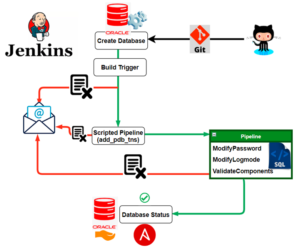- Published on
Streamlining Development A Comprehensive Guide to DevOps CI/CD Pipeline Automation
- Authors

- Name
- Adil ABBADI
Introduction
In today's fast-paced software landscape, rapid and reliable delivery is essential. DevOps practices, especially CI/CD (Continuous Integration and Continuous Deployment) pipeline automation, have revolutionized how teams ship code. By automating everything from building to testing and deployment, organizations achieve faster releases, greater consistency, and reduced manual intervention.

- Understanding DevOps and CI/CD Pipelines
- Automating Build, Test, and Deployment
- Best Practices for Reliable CI/CD Pipeline Automation
- Conclusion
- Take the Next Step in DevOps Automation
Understanding DevOps and CI/CD Pipelines
DevOps is a culture and practice that unites development and operations, aiming for continuous delivery of value. CI/CD pipelines automate critical steps such as code integrations, automated testing, packaging, and deployment.
A typical CI/CD pipeline includes the following stages:
- Continuous Integration (CI): Developers merge code changes frequently, triggering automated builds and tests.
- Continuous Delivery/Deployment (CD): Successfully tested code is automatically delivered to production or staging environments.

Sample CI/CD Pipeline Configuration (YAML)
Let's look at a simplified CI pipeline using GitHub Actions:
name: CI Pipeline
on:
push:
branches: [main]
pull_request:
branches: [main]
jobs:
build-and-test:
runs-on: ubuntu-latest
steps:
- uses: actions/checkout@v4
- name: Set up Node.js
uses: actions/setup-node@v3
with:
node-version: '18'
- run: npm install
- run: npm test
This script automatically checks out your code, installs dependencies, and runs tests whenever changes are pushed.
Automating Build, Test, and Deployment
Automation is the backbone of efficient pipelines. Build tools compile source code and package artifacts, testing frameworks automatically verify code quality, and deployment tools push updates to different environments.
Example: Automated Docker Image Build and Deployment
Suppose you're deploying a Dockerized web app to AWS Elastic Container Service (ECS). Here's how you might automate the process:
jobs:
build-deploy:
runs-on: ubuntu-latest
steps:
- uses: actions/checkout@v4
- run: docker build -t my-app:${{ github.sha }} .
- run: aws ecr get-login-password --region us-east-1 | docker login --username AWS --password-stdin <account-id>.dkr.ecr.us-east-1.amazonaws.com
- run: docker tag my-app:${{ github.sha }} <account-id>.dkr.ecr.us-east-1.amazonaws.com/my-app:${{ github.sha }}
- run: docker push <account-id>.dkr.ecr.us-east-1.amazonaws.com/my-app:${{ github.sha }}
- name: Deploy to ECS
run: |
aws ecs update-service --cluster my-cluster --service my-service --force-new-deployment
This sequence builds a Docker image, pushes it to AWS ECR, and triggers a deployment on ECS.

Best Practices for Reliable CI/CD Pipeline Automation
Implementing pipeline automation is not just about writing scripts; it requires strategic design to ensure scalability, security, and maintainability.
Key Best Practices
- Modular Pipelines: Split complex pipelines into manageable, reusable steps or jobs (e.g., separate build, test, deploy).
- Environment Parity: Mirror your staging and production environments to avoid "works on my machine" issues.
- Secure Secrets Management: Use tools like GitHub Secrets or AWS Parameter Store; never hard-code sensitive data.
- Observability: Integrate logging and alerting to monitor pipeline health and catch failures early.
- Fail Fast: Configure pipelines to halt on errors, preventing faulty artifacts from advancing to later stages.
Example: Improving Pipeline Security with Secrets
- name: Login to registry
run: echo ${{ secrets.REGISTRY_PASSWORD }} | docker login --username ${{ secrets.REGISTRY_USER }} --password-stdin
This ensures sensitive credentials are stored securely and not exposed in the pipeline code.
Conclusion
DevOps CI/CD pipeline automation unlocks expedited releases, robust testing, and reliable deployments, empowering teams to innovate with confidence. By harnessing automation and embracing best practices, organizations can transform their development workflow from sluggish and error-prone to streamlined and resilient.
Take the Next Step in DevOps Automation
Ready to level up your development process? Start by automating a small part of your pipeline, iterate, and scale as you grow. Explore advanced topics like Infrastructure as Code and pipeline-as-code to further supercharge your DevOps journey!
